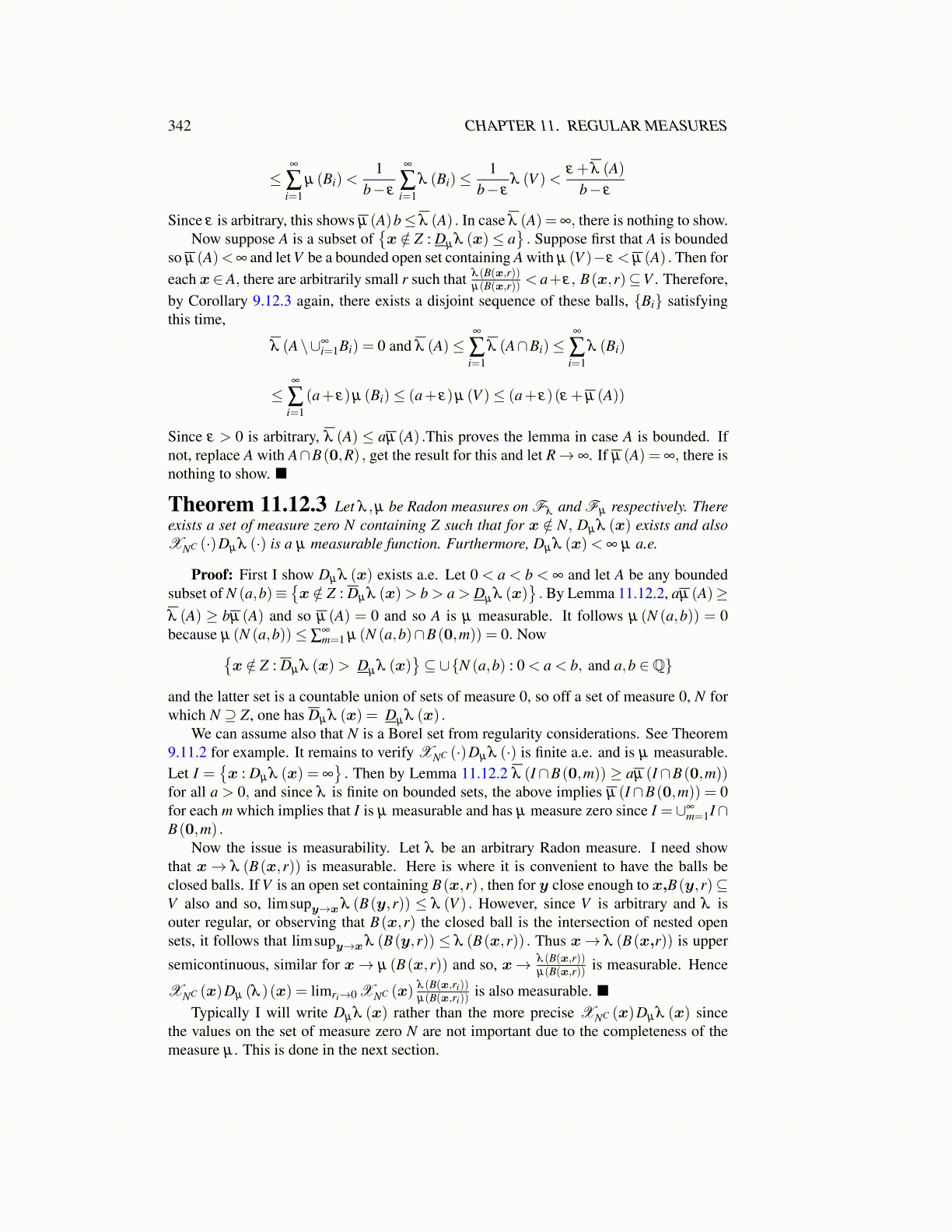
342 CHAPTER 11. REGULAR MEASURES
≤∞
∑i=1
µ (Bi)<1
b− ε
∞
∑i=1
λ (Bi)≤1
b− ελ (V )<
ε +λ (A)b− ε
Since ε is arbitrary, this shows µ (A)b≤ λ (A) . In case λ (A) = ∞, there is nothing to show.Now suppose A is a subset of
{x /∈ Z : Dµ λ (x)≤ a
}. Suppose first that A is bounded
so µ (A)<∞ and let V be a bounded open set containing A with µ (V )−ε < µ (A) . Then foreach x∈ A, there are arbitrarily small r such that λ (B(x,r))
µ(B(x,r)) < a+ε, B(x,r)⊆V . Therefore,by Corollary 9.12.3 again, there exists a disjoint sequence of these balls, {Bi} satisfyingthis time,
λ (A\∪∞i=1Bi) = 0 and λ (A)≤
∞
∑i=1
λ (A∩Bi)≤∞
∑i=1
λ (Bi)
≤∞
∑i=1
(a+ ε)µ (Bi)≤ (a+ ε)µ (V )≤ (a+ ε)(ε +µ (A))
Since ε > 0 is arbitrary, λ (A) ≤ aµ (A) .This proves the lemma in case A is bounded. Ifnot, replace A with A∩B(0,R) , get the result for this and let R→∞. If µ (A) = ∞, there isnothing to show. ■
Theorem 11.12.3 Let λ ,µ be Radon measures on Fλ and Fµ respectively. Thereexists a set of measure zero N containing Z such that for x /∈ N, Dµ λ (x) exists and alsoXNC (·)Dµ λ (·) is a µ measurable function. Furthermore, Dµ λ (x)< ∞ µ a.e.
Proof: First I show Dµ λ (x) exists a.e. Let 0 < a < b < ∞ and let A be any boundedsubset of N (a,b)≡
{x /∈ Z : Dµ λ (x)> b > a > Dµ λ (x)
}. By Lemma 11.12.2, aµ (A)≥
λ (A) ≥ bµ (A) and so µ (A) = 0 and so A is µ measurable. It follows µ (N (a,b)) = 0because µ (N (a,b))≤ ∑
∞m=1 µ (N (a,b)∩B(0,m)) = 0. Now{
x /∈ Z : Dµ λ (x)> Dµ λ (x)}⊆ ∪{N (a,b) : 0 < a < b, and a,b ∈Q}
and the latter set is a countable union of sets of measure 0, so off a set of measure 0, N forwhich N ⊇ Z, one has Dµ λ (x) = Dµ λ (x) .
We can assume also that N is a Borel set from regularity considerations. See Theorem9.11.2 for example. It remains to verify XNC (·)Dµ λ (·) is finite a.e. and is µ measurable.Let I =
{x : Dµ λ (x) = ∞
}. Then by Lemma 11.12.2 λ (I∩B(0,m)) ≥ aµ (I∩B(0,m))
for all a > 0, and since λ is finite on bounded sets, the above implies µ (I∩B(0,m)) = 0for each m which implies that I is µ measurable and has µ measure zero since I = ∪∞
m=1I∩B(0,m) .
Now the issue is measurability. Let λ be an arbitrary Radon measure. I need showthat x→ λ (B(x,r)) is measurable. Here is where it is convenient to have the balls beclosed balls. If V is an open set containing B(x,r) , then for y close enough to x,B(y,r)⊆V also and so, limsupy→x λ (B(y,r)) ≤ λ (V ) . However, since V is arbitrary and λ isouter regular, or observing that B(x,r) the closed ball is the intersection of nested opensets, it follows that limsupy→x λ (B(y,r)) ≤ λ (B(x,r)) . Thus x→ λ (B(x,r)) is upper
semicontinuous, similar for x→ µ (B(x,r)) and so, x→ λ (B(x,r))µ(B(x,r)) is measurable. Hence
XNC (x)Dµ (λ )(x) = limri→0 XNC (x)λ (B(x,ri))µ(B(x,ri))
is also measurable. ■Typically I will write Dµ λ (x) rather than the more precise XNC (x)Dµ λ (x) since
the values on the set of measure zero N are not important due to the completeness of themeasure µ . This is done in the next section.